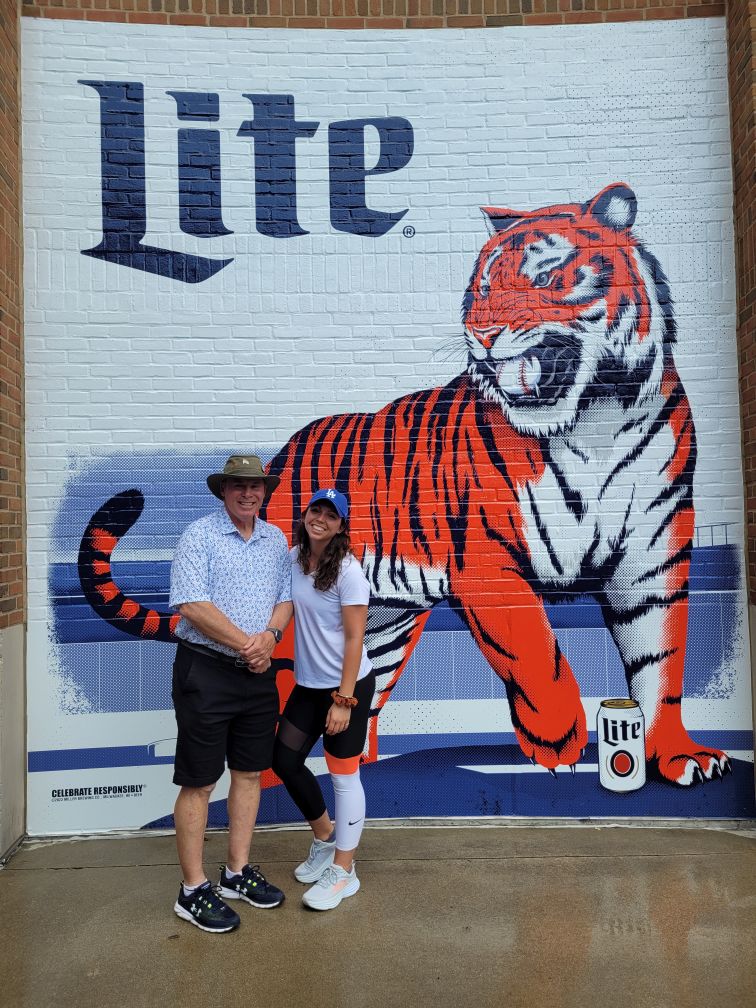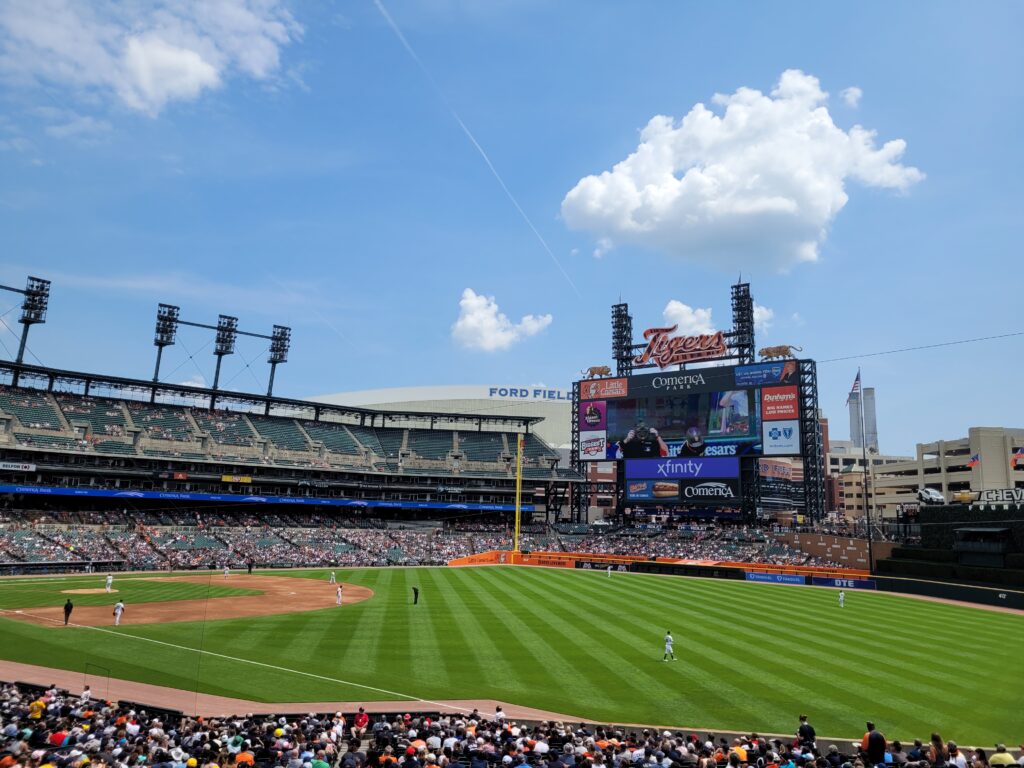By Mike May

When you attend a baseball game at Detroit’s Comerica Park, be prepared for more than a baseball game. Since Comerica Park was first opened in April 2000, those who have walked through the gates have seen a one-of-a-kind attraction – a combination ballpark, theme park, and baseball museum. That’s one of the many reasons why Major League Baseball’s mid-summer classic – the All-Star Game – was held in Detroit in July 2005.
During a game, fans have a great view of the action on the field and Detroit’s downtown skyline because there are no upper deck outfield seats. Without a doubt, what’s interesting about a visit to Comerica Park is the variety of things to eat, drink, see, and do.

HIGH-TECH DISPLAY
During a game, fans are mesmerized by the main scoreboard which is one of the largest in Major League Baseball. It was the largest of its kind when the ballpark first opened in 2000. The structure includes one video screen, one large black and white matrix board with the line score, and a color matrix board. There’s also an old-time, out-of-town scoreboard placed at field level within the wall in right-center field and a Pitch Information board which gives the speed of each pitch thrown in the game.
For those who need to satisfy their appetite, try the Big Cat Food Court, which is located near the main entrance. It offers a wide variety of food choices including fresh-squeezed lemonade, elephant ears, ice cream, French fries, handmade pretzels, deli sandwiches, gyros, and hot dogs (Coney and Chicago-style). Another dynamic food destination is the Brushfire Grill, an open-air picnic area which offers fresh grilled ballpark favorites. Another interesting feature of the Brushfire Grill is a soothing fountain with a giant baseball floating upon cascades of clear blue water.

LET’S HAVE FUN
At the base of the food court behind the first-base area, there’s an ornate carousel. As you would expect, this carousel ride features carousel tigers and not horses. There are 30 hand-painted tigers and two chariots. The ride is fully wheelchair-accessible. Believe it or not, there’s also a 50-foot Ferris wheel at Comerica Park. It features ‘cars’ shaped like baseballs that can seat up to five passengers and is wheelchair accessible. The centerfield wall features a giant water fountain that produces a stunning ‘liquid’ fireworks display. It is synchronized to music and changing lights. It’s used to celebrate home runs and other in-game moments. If you are in Detroit when the Tigers are on the road, you can see the ballpark with a guided tour. These tours are only provided on non-game days from early June to early September. Group tours for parties of 15 or more are available from April to September.
MEMORY LANE
The Tigers celebrate six of their all-time great players with a series of unique statues located along the left centerfield wall. The statues are cast in stainless steel and capture the essence of some of the greatest Tigers in action – Ty Cobb, Charlie Gehringer, Hank Greenberg, Willie Horton, Al Kaline, and Hal Newhouser. Each is perched atop a granite pedestal and reaches about 13 feet in height. All through the main concourse, guests can enjoy the Tigers ‘Walk of Fame,’ a historical display that can be found in the lower level. Historical elements celebrating the Tigers rich history from the late 1800s to the present take guests on a trip through time, punctuated by six large ‘decade bats’ that denote each era in Tigers baseball with artifacts, photos, and display cases.

INSIDE THE NUMBERS
For diehard baseball fans that are interested in the dimensions of Comerica Park, here they are: 346 feet to the left field fence; 402 feet to the left field power alley; 422 feel to straight-away center field; 379 feet to the right field power alley; and 330 feet to the right field fence.

HOME SWEET HOME
When the Detroit Tigers started playing baseball in the 1880s, they played at Bennett Park. In 1912, the Tigers moved to Navin Field. In 1938, Briggs Stadium became the third home of the Tigers. Briggs Stadium was the setting for Major League Baseball’s All-Star Game in 1941 and in 1951. And, in 1961, historic Tiger Stadium – home of Major League Baseball’s All-Star Game in 1971 – became the fourth home field for the Tigers. And, now the Tigers live and play at Comerica Park, right across the street – literally – from the home of the Lions, that being Ford Field.
For complete details on Comerica Park and the Detroit Tigers, access www.Tigers.com.
Comerica Park awaits your arrival!

